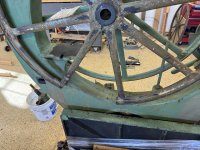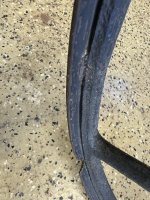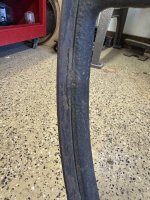Welding is a very bad idea on that. You are very likely to get cracking elsewhere as it cools. Blast it clean and then clean with acetone. Shape a piece of graphite with a file to fit closely to the underside of the rim, preheat and silicone braze the spot to be filled and immediately wrap with insulation and let cool. Very little file work with a smooth cut file would be needed to bring it back to the original shape.
You are using an out of date browser. It may not display this or other websites correctly.
You should upgrade or use an alternative browser.
You should upgrade or use an alternative browser.
Cast iron repair
- Thread starter WinterDeere
- Start date
/ Cast iron repair
#11
etpm
Veteran Member
I also would use silicon bronze rod with a TIG machine. Clean well first. Then I would heat the whole wheel with a weed burner, wrap with ceramic wool or similar, then with just the area to be brazed exposed fill with silicon bronze. Wrap completely. Let cool slowly and then grind to shape. Any decent weld shop would make the repair in a similar fashion.TIG using silicon/bronze. After cleaning the area, warm the whole wheel up to take the chill off it, build it up using silicon bronze and grind to suit. Just remember, you're brazing not welding so you don't melt the base metal. Worst thing with a spoke wheel is the stresses that build up in places you wouldn't think, that's the reason for warming the whole thing up.
Eric
WinterDeere
Elite Member
I highly doubt its welded. More than likely furnaced brazed if it is but I would even question that. Pictures are hard to tell exactly what that blob is. Take a small sharp caping chisel and see if its just old paint or hardened grease/metal chips.Game changer, guys. Realized when I got back out to the shop after lunch… that ain’t cast iron! Wheel appears to be a steel hoop welded to cast iron spoke and hub assembly. See photos
View attachment 854233 View attachment 854234
You can grind on an inconspicuous spot and observe the spark pattern
Cast iron and steel have very different spark patterns.
WinterDeere
Elite Member
This is a wood cutting bandsaw, so no way is it metal chips, etc. But I'll go at it tomorrow with something to expose metal, and see what it is. It could be a steel hoop that was heated to expand, and then cooled in place onto the cast iron wheel, then torch-welded or brazed in a few spots. Think 1920's tech. But either way, up-close inspection reveals the hoop is definitely a separate piece from the cast wheel, and I do believe the hoop is steel.
One more wrinkle, this chipped wheel is just a replacement wheel, which has a different hub configuration from the original upper wheel. So, if I use it, I still have some work to reconfigure and bush out the hub.
On the flip side, I also have the original, but a whole section has been broken out of it. I have those pieces, but had assumed skarfing them back in to make a repair was impractical:

Third option is just have a whole new wheel made. Could have replica of original cast by Cattail Foundry, and then turned and balanced by a local machine shop. If doing that, I'd just scarf the original back together and let the guys at the foundry build it up, to use the original as a mold for a new wheel.
Fourth option is to keep shopping for another wheel. But on a 100+ year old machine of a less common size, they don't come up very often, and more often than not they're worse than what I already have.
One more wrinkle, this chipped wheel is just a replacement wheel, which has a different hub configuration from the original upper wheel. So, if I use it, I still have some work to reconfigure and bush out the hub.
On the flip side, I also have the original, but a whole section has been broken out of it. I have those pieces, but had assumed skarfing them back in to make a repair was impractical:

Third option is just have a whole new wheel made. Could have replica of original cast by Cattail Foundry, and then turned and balanced by a local machine shop. If doing that, I'd just scarf the original back together and let the guys at the foundry build it up, to use the original as a mold for a new wheel.
Fourth option is to keep shopping for another wheel. But on a 100+ year old machine of a less common size, they don't come up very often, and more often than not they're worse than what I already have.
Last edited:
WranglerX
Elite Member
IF its steel. build it up with any weld process and grind to conform with rest of wheel diameter.... Personally I would use MIG or Braze, but that is what I have available to me....
jwmorris
Veteran Member
- Joined
- Oct 3, 2007
- Messages
- 1,039
I'd work on the original wheel myself a break in a thicker section is easier than building up thin.
The process I would use would be similar to this repair.

 www.tractorbynet.com
www.tractorbynet.com
No need to have to repair and then modify to fit, if you are using the original part.
The process I would use would be similar to this repair.

One way to repair cast iron.
This is a method I use fairly often for cast iron repairs, using a TIG welder and silicon bronze filler rod. Broken part is sand blasted, with most attention on fracture area. Set up parts so fracture is aligned just "sitting there", a clamp and shims can help. Grind away material to gain...
No need to have to repair and then modify to fit, if you are using the original part.
rScotty
Super Member
- Joined
- Apr 21, 2001
- Messages
- 8,258
- Location
- Rural mountains - Colorado
- Tractor
- Kubota M59, JD530, JD310SG. Restoring Yanmar YM165D
This is a wood cutting bandsaw, so no way is it metal chips, etc. But I'll go at it tomorrow with something to expose metal, and see what it is. It could be a steel hoop that was heated to expand, and then cooled in place onto the cast iron wheel, then torch-welded or brazed in a few spots. Think 1920's tech. But either way, up-close inspection reveals the hoop is definitely a separate piece from the cast wheel, and I do believe the hoop is steel.
One more wrinkle, this chipped wheel is just a replacement wheel, which has a different hub configuration from the original upper wheel. So, if I use it, I still have some work to reconfigure and bush out the hub.
On the flip side, I also have the original, but a whole section has been broken out of it. I have those pieces, but had assumed skarfing them back in to make a repair was impractical:
View attachment 854272
Third option is just have a whole new wheel made. Could have replica of original cast by Cattail Foundry, and then turned and balanced by a local machine shop. If doing that, I'd just scarf the original back together and let the guys at the foundry build it up, to use the original as a mold for a new wheel.
Fourth option is to keep shopping for another wheel. But on a 100+ year old machine of a less common size, they don't come up very often, and more often than not they're worse than what I already have.
Thank you for the explanation. I've done some foundary work, and went to bed after reading on your project and got to wondering how they could cast that wheel and keep the outer flange in one piece, much less keep it round. Banding a steel rim to affix to cast spokes does make a whole lot more sense.
In fact, as I look at your original wheel is it possible that the outer band was originally riveted to the spokes? Look at the lower rt hand corner of the photo...is that a riveted joint? And if so, are many of the other spoke attachents welded repairs?
If so, then the original was made in two pieces as well. Again that makes more sense than a cast wheel of those dimensions. I think it would almost have to be two pieces if it was cast.
And the same reason - thermal stresses - is why any welding/brazing process is going to be difficult. Brazing is the most likely way to fix it, but best way is to heat the whole piece up to near brazing temperature in a sand box in a furnace. Foundarys do that all the time. Then braze it, and then a 24 hour cool. And even so it might not work. That kind of temperature cycle can expose all sorts of age-related stresses.
Bottom line is if this is a project that matters, I would take both wheels down to your local Foundary and have a chat with them.
rScotty
LouNY
Super Star Member
- Joined
- Jul 4, 2015
- Messages
- 10,742
- Location
- Greenwich, NY
- Tractor
- Branson 8050, IH 574, Oliver 1550 Diesel Utility (traded in on Branson) NH 8160. Kioti CK2620SECH
I'd go with your third option have a blacksmith cast a new wheel and shrink a new wheel to it. Or most any machine shop could fabricate you a new wheel out of steel.This is a wood cutting bandsaw, so no way is it metal chips, etc. But I'll go at it tomorrow with something to expose metal, and see what it is. It could be a steel hoop that was heated to expand, and then cooled in place onto the cast iron wheel, then torch-welded or brazed in a few spots. Think 1920's tech. But either way, up-close inspection reveals the hoop is definitely a separate piece from the cast wheel, and I do believe the hoop is steel.
One more wrinkle, this chipped wheel is just a replacement wheel, which has a different hub configuration from the original upper wheel. So, if I use it, I still have some work to reconfigure and bush out the hub.
On the flip side, I also have the original, but a whole section has been broken out of it. I have those pieces, but had assumed skarfing them back in to make a repair was impractical:
View attachment 854272
Third option is just have a whole new wheel made. Could have replica of original cast by Cattail Foundry, and then turned and balanced by a local machine shop. If doing that, I'd just scarf the original back together and let the guys at the foundry build it up, to use the original as a mold for a new wheel.
Fourth option is to keep shopping for another wheel. But on a 100+ year old machine of a less common size, they don't come up very often, and more often than not they're worse than what I already have.

